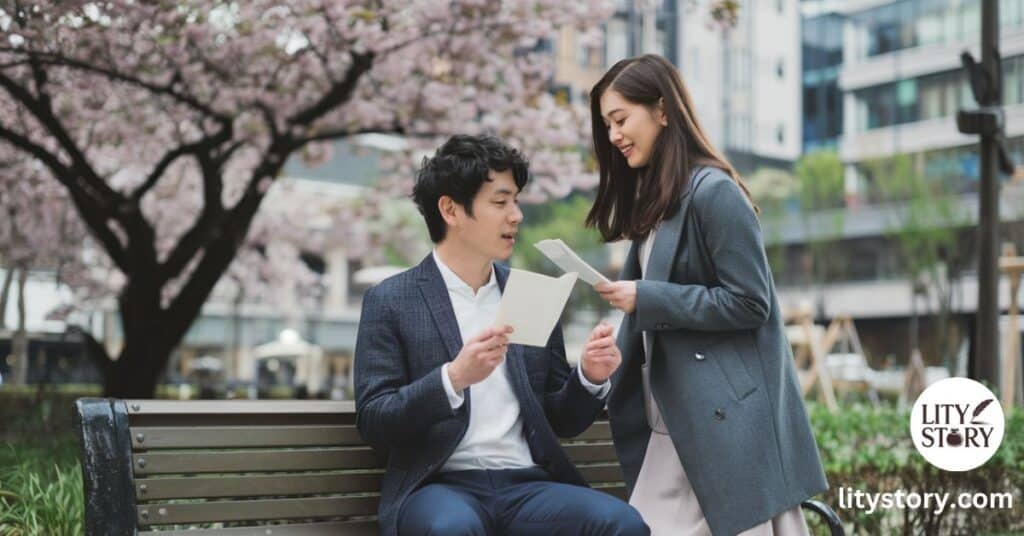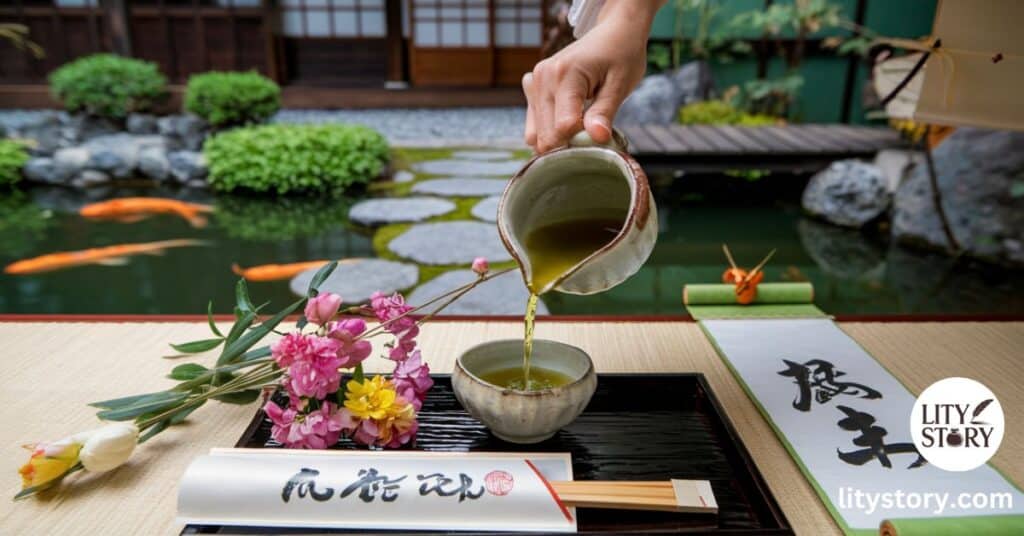Japanese Love Poems have a long, rich history rooted in the culture of Japan. These poems beautifully capture the emotional depth of human relationships and explore themes of love, longing, and nature. Unlike many other literary traditions, Japanese poetry often conveys profound feelings in just a few lines, making it both concise and powerful. From the classical waka and tanka forms to modern haiku, these poems reflect timeless connections and continue to influence global poetry today.
In this comprehensive blog post, we’ll take you on a journey through the world of Japanese love poetry, exploring its origins, forms, themes, and notable poets. We’ll also dive into how Japanese love poems express the relationship between nature and love, and how they continue to inspire poets and lovers worldwide. To enrich the experience, we’ll include original poems and offer practical guidance on how you can write your own Japanese love poem.
Let’s explore this beautiful art form.
Classical Era: The Heian Period (794–1185)

The Heian Period was a golden age of literature in Japan, where aristocratic life heavily influenced artistic expression, especially in poetry. During this time, poetry was the primary means of communication between lovers, and many exchanged short verses as part of courtship rituals. The waka and tanka, traditional Japanese poetic forms, became especially popular for expressing love and emotion.
The aristocracy’s lifestyle, focused on aesthetics and refinement, gave birth to a unique poetic culture. For example, lovers often exchanged poems as a way of communicating their feelings when words alone were insufficient. The interplay of romantic imagery, such as the moonlit vows and cherry blossoms, conveyed deep emotions while maintaining a sense of decorum.
Influence of Nature and Seasonal Imagery
Nature and love are inextricably linked in Japanese love poems, and the seasons often serve as metaphors for emotional states. The cherry blossoms (sakura), for instance, symbolize the fleeting nature of life and love, while autumn leaves (momiji) represent sorrow and separation. The concept of mono no aware, or the “pathos of things,” reflects the beauty found in impermanence.
In many love poems, the speaker’s feelings are mirrored by the natural surroundings, with images like the wind, moonlight, and blossoms all contributing to the emotional landscape. Here’s an example:
Poem
“Under the moonlight,
our whispered vows float away,
carried by the wind—
yet the cherry blossoms fall,
reminding me of your touch.”
This poem captures both the beauty and the transience of love, expressed through nature’s elements.
Forms of Japanese Love Poetry

Japanese love poetry has evolved over centuries, but three main forms stand out: waka, haiku, and renga. Each form has its own structure and style, yet they all convey deep emotional meaning.
Waka and Tanka: The Classical Form of Love Expression
Waka is the umbrella term for classical Japanese poetry, but tanka is the most prominent form when it comes to love poems. A tanka consists of 31 syllables in a 5-7-5-7-7 pattern, making it concise yet emotionally potent.
In tanka, the brevity forces poets to focus on imagery and emotion, often evoking feelings of longing or unrequited love. Many of these poems were exchanged between lovers, serving as tokens of affection or sorrow.
Famous Tanka Example (By Ono no Komachi):
“Even if I sleep
with my hair tangled in yours,
I will still dream
of us walking in the night
beneath the blossoming trees.”
This poem vividly portrays the closeness and intimacy of love, using simple yet powerful imagery.
Haiku and Love: Capturing Fleeting Moments
While the haiku is often associated with nature, it can also express love in a minimalist yet impactful way. With just 17 syllables (5-7-5), haiku captures fleeting moments of emotion, much like a snapshot of a feeling or scene. In the context of love, haiku often uses subtle imagery to evoke deep emotional responses.
Poem
“A falling petal—
your hand slips out of mine
under starlit skies.”
This haiku conveys the pain of parting, reflected in the image of a falling cherry blossom petal, a common symbol in Japanese romance.
Renga: A Collaborative Love Story
Renga (linked verse) is a collaborative form of poetry where two or more poets alternate stanzas to create a longer poem. Love renga often mirrored the exchange between lovers, with each poet building upon the other’s lines to tell a story of love, longing, and connection.
In this form, reciprocity is key, reflecting the give-and-take of a relationship. The shared creation of a poem becomes a metaphor for the emotional connection between lovers.
Example (Poet A and Poet B):
“By the flowing stream,
I wait for your gentle voice—
in the autumn dusk.” (Poet A)
“The wind carries it,
soft whispers on the wind, love,
as leaves fall like tears.” (Poet B)
This back-and-forth format mirrors the emotional exchange between two people, creating a layered and rich expression of love.
Themes in Japanese Love Poems

Unrequited Love: The Pain of Longing
Unrequited love is a major theme in Japanese love poems. Many poets use subtle, symbolic language to express the ache of longing for someone who may never return their feelings. This theme often intertwines with the idea of impermanence, reflecting the emotional depth of transcending love.
Poem
“Though the moon is full,
its light cannot fill my heart—
still, I wait for you.“
In this poem, the speaker’s yearning for the beloved is represented by the full moon, which illuminates everything except their heart.
The Beauty of Transience: Love as Fleeting
In Japanese poetry, love is often seen as transient and bittersweet. The fleeting beauty of a moment, like the blossoming and falling of cherry blossoms, serves as a metaphor for the impermanence of relationships. This concept of mono no aware permeates much of Japanese love poetry.
Poem
“Just as blossoms fall,
our love, too, must fade away—
yet its memory
will live on beneath the stars,
whispers on the wind of time.”
Here, the cherry blossoms symbolize the ephemeral nature of love, while the wind represents the lingering memory of that love.
Separation and Distance: Lovers Apart
Many Japanese love poems deal with the theme of separation, either due to physical distance or emotional barriers. These poems often use images of rivers, mountains, and the sea to represent the obstacles between lovers.
Poem
“Beyond the mountains,
your love feels so far away—
yet the stars connect
our starlight wishes tonight,
a vow that time cannot break.”
This poem uses the stars to symbolize the eternal bond between lovers, despite the physical distance that separates them.
Spiritual and Physical Love: A Delicate Balance
Japanese love poetry often explores the balance between spiritual and physical love. Some poems focus on the deep, spiritual connection between lovers, while others celebrate the physical aspects of love. In either case, the imagery remains subtle and poetic.
Poem
“In the quiet night,
I feel your breath on my skin,
a starlight promise
that our hearts will always beat
in time with the moonlit vows.”
Here, the moon and stars represent the spiritual connection, while the breath on the skin evokes the physical closeness of lovers.
Notable Poets and Their Contributions to Love Poetry

Lady Murasaki: A Pioneer of Love Poetry
Lady Murasaki, best known for her literary masterpiece The Tale of Genji, also contributed to Japanese love poetry. Her works often depicted the complex emotions of romantic relationships in the aristocratic court, offering a deep exploration of love, longing, and heartbreak.
Ono no Komachi: The Queen of Unrequited Love
Ono no Komachi is famous for her poignant love poems that reflect the sorrow and beauty of unrequited love. Her poems often used nature as a metaphor for her emotional state, and her works remain some of the most celebrated in Japanese literature.
Matsuo Basho: The Master of Haiku and Love
Matsuo Basho, the most famous haiku
poet, also wrote haiku that touched on themes of love and longing. His haiku are known for their simplicity and emotional depth, often using nature to express the fleeting nature of love.
Yosano Akiko: Celebrating Passion and Physical Love
In the modern era, Yosano Akiko became famous for her bold, passionate love poems that broke away from the more restrained traditions of classical Japanese poetry. Her works celebrated both the spiritual and physical aspects of love, often with vivid, erotic imagery.
Japanese Love Poems in Modern Times

Contemporary Poets: Keeping the Tradition Alive
Even in modern times, Japanese poets continue to write love poems, often blending traditional forms like tanka and haiku with modern themes and language. These poems maintain the emotional depth and romantic imagery of classical poetry while addressing contemporary issues like urban life and modern relationships.
Love Poems in Popular Culture: Anime, Movies, and Literature
Japanese love poems continue to influence popular culture, especially in mediums like anime, manga, and film. Many of these works use traditional poetic imagery—such as cherry blossoms or moonlit vows—to convey deep emotions in stories of romance and heartbreak.
Influence on Western Poets: A Cross-Cultural Exchange
Japanese love poetry has also inspired many Western poets, particularly in the use of haiku and minimalist imagery. Poets such as Ezra Pound and Gary Snyder have drawn from the Japanese tradition to explore themes of love, nature, and transience.
How to Write Your Own Japanese Love Poem

Understanding the Structure
To write your own Japanese love poem, it’s important to understand the basic structure of traditional forms like tanka and haiku. A tanka follows a 5-7-5-7-7 syllable structure, while a haiku uses a 5-7-5 pattern. Keep the language simple and focus on imagery and emotion.
Incorporating Japanese Themes
When writing a Japanese love poem, consider incorporating themes like nature, transience, and longing. Use imagery that reflects the emotions you want to convey, such as the falling of cherry blossoms for unrequited love or the moon for eternal love.
Examples and Writing Prompts
To get started, try writing a tanka about a personal experience of love. Here’s a writing prompt:
Prompt: Write a tanka about the feeling of seeing a loved one after a long separation. Use natural imagery like the changing seasons or the night sky to convey your emotions.
Poem Example
“As the leaves turn red,
I find your face in the stars—
though we’ve been apart,
our love remains ever bright,
a flame that time cannot dim.”
Conclusion
Japanese love poems have a unique ability to express the deepest human emotions with simplicity and grace. Whether exploring themes of unrequited love, separation, or spiritual connection, these poems offer timeless insights into the nature of love and relationships. By using symbolic imagery and focusing on the beauty of transience, Japanese poets have created a legacy of love poetry that continues to inspire readers and writers around the world.
If you’ve ever been moved by the sight of cherry blossoms or the glow of the moon, you’ve already experienced the essence of Japanese love poetry. Now, it’s your turn to try writing your own. As you craft your poems, remember the delicate balance of nature and emotion that defines this beautiful tradition.

Litystoyr is the creative mind behind Litystory, a blog dedicated to helping readers navigate the complexities of canceling and activating various subscriptions. With clear, actionable advice, Litystoyr simplifies the process for users looking for easy solutions to subscription management and more.








